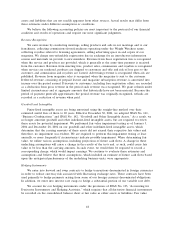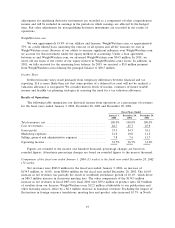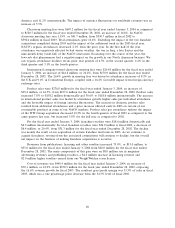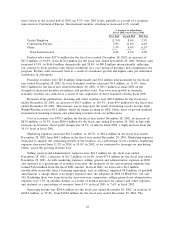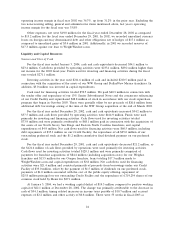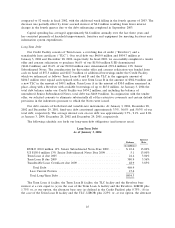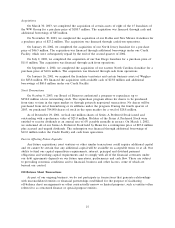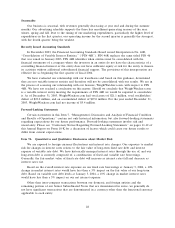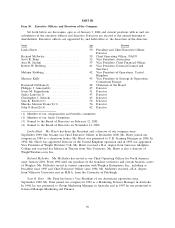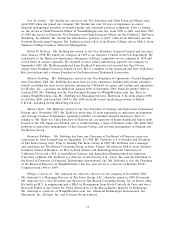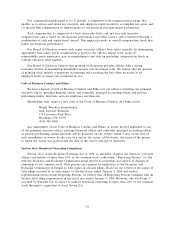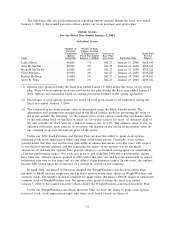WeightWatchers 2003 Annual Report Download - page 34
Download and view the complete annual report
Please find page 34 of the 2003 WeightWatchers annual report below. You can navigate through the pages in the report by either clicking on the pages listed below, or by using the keyword search tool below to find specific information within the annual report.Seasonality
Our business is seasonal, with revenues generally decreasing at year end and during the summer
months. Our advertising schedule supports the three key enrollment-generating seasons of the year:
winter, spring and fall. Due to the timing of our marketing expenditures, particularly the higher level of
expenditures in the first quarter, our operating income for the second quarter is generally the strongest,
with the fourth quarter being the weakest.
Recently Issued Accounting Standards
In December 2003, the Financial Accounting Standards Board issued Interpretation No. 46R,
‘‘Consolidation of Variable Interest Entities,’’ (‘‘FIN 46R’’). FIN 46R replaces the same titled FIN 46
that was issued in January 2003. FIN 46R identifies when entities must be consolidated with the
financial statements of a company where the investors in an entity do not have the characteristics of a
controlling financial interest or the entity does not have sufficient equity at risk for the entity to finance
its activities without additional subordinated financial support. The provisions of this interpretation are
effective for us beginning the first quarter of fiscal 2004.
We have evaluated our relationship with our franchisees and based on this guidance, determined
they are not variable interest entities and therefore will not be consolidated with our results. We are in
the process of assessing our relationship with our licensee, WeightWatchers.com, with respect to FIN
46R. We have not reached a conclusion on this matter. Should we conclude that WeightWatchers.com
is a variable interest entity meeting the requirements of FIN 46R we would be required to consolidate
it. As of December 31, 2003, WeightWatchers.com had total assets of $21.1 million, total stockholders’
deficit of $23.0 million, and an accumulated deficit of $27.0 million. For the year ended December 31,
2003, WeightWatchers.com had net income of $5.4 million.
Forward-Looking Statements
Certain statements in this Item 7, ‘‘Management’s Discussion and Analysis of Financial Condition
and Results of Operations,’’ contain not only historical information, but also forward-looking statements
regarding expectations for our future performance. Forward-looking statements involve risk and
uncertainty. Please see ‘‘Cautionary Notice Regarding Forward-Looking Statements’’ on pages 11-12 of
this Annual Report on Form 10-K for a discussion of factors which could cause our future results to
differ from current expectations.
Item 7A. Quantitative and Qualitative Disclosures about Market Risk
We are exposed to foreign currency fluctuations and interest rate changes. Our exposure to market
risk for changes in interest rates relates to the fair value of long-term fixed rate debt and interest
expense of variable rate debt. We have historically managed interest rates through the use of, and our
long-term debt is currently composed of, a combination of fixed and variable rate borrowings.
Generally, the fair market value of fixed rate debt will increase as interest rates fall and decrease as
interest rates rise.
Based on the overall interest rate exposure on our fixed rate borrowings at January 3, 2004, a 10%
change in market interest rates would have less than a 5% impact on the fair value of our long-term
debt. Based on variable rate debt levels at January 3, 2004, a 10% change in market interest rates
would have less than a 5% impact on our net interest expense.
Other than inter-company transactions between our domestic and foreign entities and the
remaining portion of our Senior Subordinated Notes that are denominated in euros, we generally do
not have significant transactions that are denominated in a currency other than the functional currency
applicable to each entity.
28


